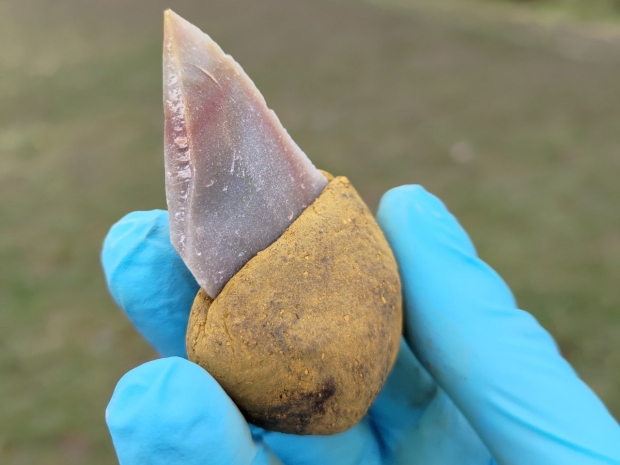TOOL ANALYSIS SUGGESTS NEANDERTHALS MIXED COMPOUND ADHESIVES

(Courtesy of Patrick Schmidt, University of Tübingen)

(Courtesy of Patrick Schmidt, University of Tübingen)
NEW YORK, NEW YORK—According to a statement released by New York University, stone tools recovered in France from the Neanderthal site of Le Moustier in the 1960s have been reexamined by an international team of researchers. The team, led by Patrick Schmidt of the University of Tübingen, detected traces of ocher and bitumen on several of the scrapers, flakes, and blades. “We were surprised that the ochre content was more than 50 percent,” Schmidt said. “This is because air-dried bitumen can be used unaltered as an adhesive, but loses its adhesive properties when such large proportions of ochre are added,” he explained. The researchers then tested liquid bitumen and bitumen mixed with various levels of ocher. They found that a mix made up of 55 percent ocher and 45 percent bitumen was just sticky enough to hold a stone tool and yet not stick to the hands, making it a suitable handle. Team member Radu Iovita of New York University said that microscopic examination of the ancient tools revealed wear on the sharp edges from use on other materials, and bright polish on other areas of the tools, where they may have been abraded by the movement of the tool within a grip made of ocher and bitumen. “Compound adhesives are considered to be among the first expressions of the modern cognitive processes that are still active today,” Schmidt concluded. Read the original scholarly article about this research in Science Advances. To read about the earliest known piece of cord, go to “Twisted Neanderthal Tech.”
News
The Hanging Temple: China’s 1,500-Year-Old Cliffside Marvel of Faith and Engineering
The Hanging Temple: China’s 1,500-Year-Old Cliffside Marvel of Faith and Engineering Perched precariously on the cliffs of Mount Heng in Shanxi Province, China, the Hanging Temple, also known as Xuankong Temple, Hengshan Hanging Temple, or Hanging Monastery, is an architectural…
The Willendorf Venus: A 30,000-Year-Old Masterpiece Reveals Astonishing Secrets
The Willendorf Venus: A 30,000-Year-Old Masterpiece Reveals Astonishing Secrets The “Willendorf Venus” stands as one of the most revered archaeological treasures from the Upper Paleolithic era. Discovered in 1908 by scientist Johann Veran near Willendorf, Austria, this small yet profound…
Unveiling the Maya: Hallucinogens and Rituals Beneath the Yucatán Ball Courts
Unveiling the Maya: Hallucinogens and Rituals Beneath the Yucatán Ball Courts New archaeological research has uncovered intriguing insights into the ritual practices of the ancient Maya civilization. The focus of this study is a ceremonial offering found beneath the sediment…
Uncovering the Oldest Agricultural Machine: The Threshing Sledge’s Neolithic Origins
Uncovering the Oldest Agricultural Machine: The Threshing Sledge’s Neolithic Origins The history of agricultural innovation is a fascinating journey that spans thousands of years, and one of the earliest known agricultural machines is the threshing sledge. Recently, a groundbreaking study…
Nara’s Ancient Sword: A 1,600-Year-Old Protector Against Evil Spirits
Nara’s Ancient Sword: A 1,600-Year-Old Protector Against Evil Spirits In a remarkable discovery that has captured the attention of archaeologists and historians alike, a 7.5-foot-long iron sword was unearthed from a 1,600-year-old burial mound in Nara, Japan. This oversized weapon,…
The Inflatable Plane, Dropped Behind the Lines for Downed Pilots
Experimental The Inflatable Plane, Dropped Behind the Lines for Downed Pilots The Inflatoplane from Goodyear was an unconventional aircraft developed by the Goodyear Aircraft Company, a branch of the renowned Goodyear Tire and Rubber Company, also famed for the Goodyear…
End of content
No more pages to load











